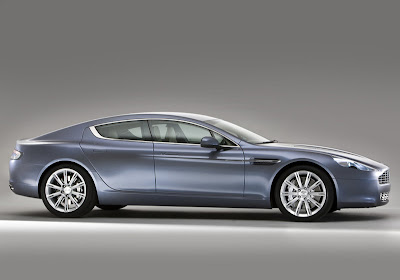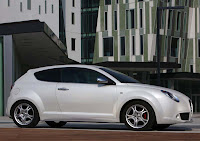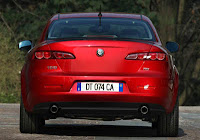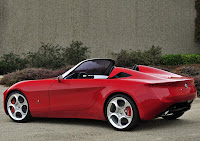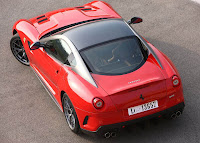Aston Martin Rapide, 2010
The Aston Martin Rapide, one of the most eagerly awaited cars of 2009, was unveiled at the 63rd Frankfurt Motorshow. The elegant Aston Martin Rapide, functional yet luxurious, provides space for up to four adults combined with an engaging driving experience synonymous with all Aston Martins.
As the marque's first production four-door sports car, Aston Martin Rapide encapsulates core values of Power, Beauty and Soul; four 'swan wing' doors provide access to cosseting sports seats both front and rear bestowing occupants with ample accommodation. A 301 litre luggage compartment affords generous space for belongings for all four passengers whether they be sports bags or indeed, sets of skis, creating an Aston Martin which can be enjoyed on any occasion, anytime, anywhere.
Aston Martin Rapide's rear environment has been intelligently packaged to create a space where passengers feel a part of the driving experience with clear views to the front and sides. Comfort and support is supplied in the form of two hand trimmed individual seats and a personal face-level heating and air conditioning system. Aiding the practicalities of everyday use, the luggage compartment features a movable bulkhead to permit access from the rear cabin while the rear seats fold flat at the touch of a button to create a flat loading space increasing the luggage compartment from 301 litres to 750 litres.
At the heart of every Aston Martin lies an evocative engine providing effortless power and torque: Aston Martin Rapide features a hand-built 6.0-litre V12 engine producing 470 bhp (477 PS / 350 kW) with peak power being delivered at 6000 rpm and 600 Nm (443 lbft) peak torque at 5000 rpm. A specifically tuned six-speed Touchtronic 2 automatic transmission features as standard, allowing the driver to change gear automatically or manually via the steering column-mounted magnesium paddles.
First shown in 2006 in concept form at the Detroit Auto Show, the Aston Martin Rapide project received an immediate green light from Aston Martin's new shareholders in mid 2007 following the sale of the marque by the Ford Motor Company. In a little over two years, Aston Martin's design and engineering team have delivered a new car from the ground up. Aston Martin Rapide has been developed from the 'V/H Architecture' platform which already forms the backbone to Aston Martin's critically acclaimed line-up: the Aston Martin DBS, DB9 and Vantage range.
The Aston Martin Rapide suggests a new world of possibilities for the Aston Martin enthusiast, a car capable of long distances at high speed, providing both a driver-focused environment and refined and cosseting interior for its passengers. The Aston Martin Rapide turns every journey into an event.
The Aston Martin Rapide brings pure function to the Aston Martin experience, a car that combines everyday practicality with elegant form and exceptional power. "Now there is an Aston Martin for every type of sports car customer regardless of the demands of their lifestyle," says Aston Martin Chief Executive, Dr. Ulrich Bez, "the Aston Martin Rapide is our most versatile product, bringing a new benchmark of luxury and refinement to both driver and passenger."
Within the flowing, muscular form of the Aston Martin Rapide, four individual seats and a spacious luggage compartment present a new type of rapid family transportation; swift, spacious, dynamic and social. Four adults can enjoy the Aston Martin Rapide in complete comfort, savouring the ride quality, the ambience of the hand-trimmed cabin and the sensation of speed and dynamism derived from the low seating position and excellent visibility.
The Aston Martin Rapide is also a practical family car, with a highly bespoke interior offering myriad possibilities for personalisation thanks to Aston Martin's acclaimed craft skills. From the highly detailed stitching on the leather, inspired by saddle-making, to the hand-machined switchgear, aluminium speaker meshes and metal door pulls, the interior is supremely tactile and rewarding.
The Aston Martin Rapide features Bang & Olufsen's acclaimed audio system, developed in close collaboration with Aston Martin to ensure the most accurate sound reproduction is achieved within the cabin environment. Twin DVD screens integrated into the front seats provide entertainment for the rear passengers, giving them the opportunity to watch a film or create their own personal soundtrack to accompany the drive. When music is shared, Bang & Olufsen's signature motorised tweeters rise from either side of the Aston Martin Rapide's dashboard, helping disperse the sound crisply and precisely throughout the length of the cabin.
When the road becomes more demanding, Aston Martin's sporting heritage comes to the fore, ensuring the driving experience is never less than sensational. The passengers can also enjoy close involvement with the way ahead, thanks to a seating arrangement that gives excellent forward visibility. 'As a rear passenger you're seated inboard, slightly above the driver, looking through the centre of the car,' Aston Martin Director of Design, Marek Reichman explains, 'so you can see forward and experience the driver's view of the road ahead. As a result, even rear passengers feel that they're in a sports car.'
The Aston Martin Rapide also excels as an occasional load-hauler, with individually folding rear seats - at the push of a button - to allow the rear luggage space to expand to up to 750 litres, facilitating the occasional bulky impulse purchase, or creating the ultimate long-distance holiday cruiser, able to transport skis or hiking equipment, hatboxes or trunks across continents with ease. The rear luggage compartment is accessed through an opening tailgate and separated from the cabin by a movable bulkhead that can be set to create a unified internal space running from the dashboard through to the tailgate, or provide a security cover for when the car is parked. Aston Martin offers a bespoke five-piece luggage set for the discerning traveller, tailored to precisely match your chosen interior trim.
The Aston Martin Rapide encapsulates the values of Aston Martin in a sporting saloon, a four-door sports car with unrivalled performance, extremely high levels of craftsmanship and exceptionally elegant design. The Aston Martin Rapide is a car to savour and share, a characterful, expressive sports grand tourer that extends the Aston Martin experience to an entire family, a group of colleagues or other performance enthusiasts. Beauty, power and practicality have never been presented so seductively






